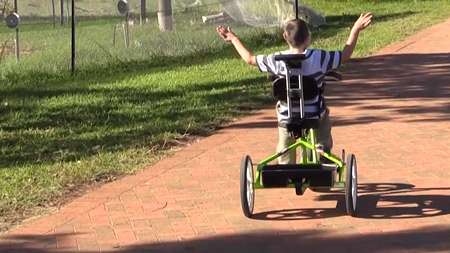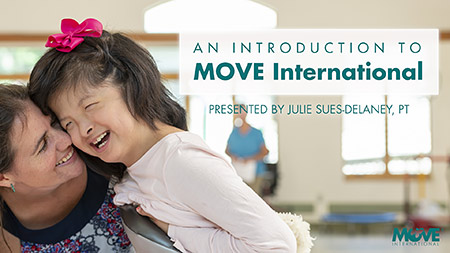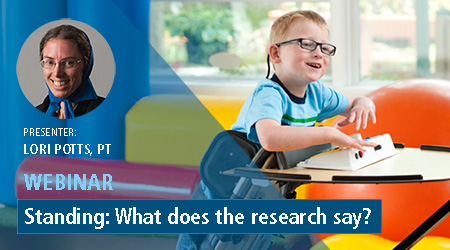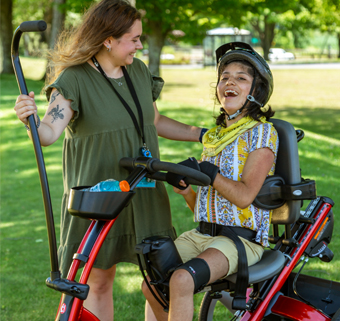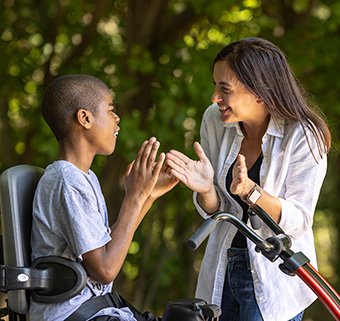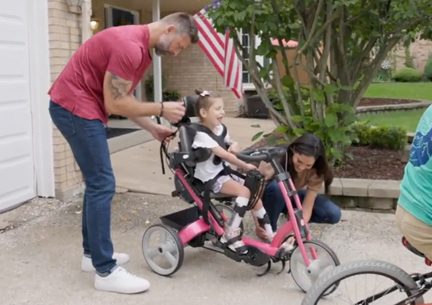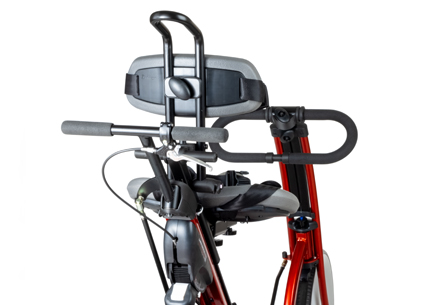Adaptive Cycling as an Effective Intervention
This 35-minute webinar provides an introduction to adaptive cycling as an effective intervention for individuals with disabilities. Adaptive cycling offers a solution for achieving published physical activity guidelines, and promotes health as described by the current framework of the International Classification of Functioning, Disability and Health. The webinar incorporates an overview of the specific benefits of cycling as evidenced in research with children with cerebral palsy and autism, and concludes with case examples.
WHO Guidelines on Physical Activity
[00:00] Michelle Meier, PT, DPT: Hi, my name is Michelle Meier. I’m a physical therapist with Rifton equipment. Today I’m going to talk about adaptive cycling.
So first we’ll start with the recently updated World Health Organization (or WHO) guidelines for physical activity and sedentary behavior. These guidelines were developed for children, adolescents, adults and older adults; and they’re based on the most recent advances in the research. So for the first time these guidelines include specific recommendations on physical activity for people living with disabilities or chronic conditions.
The guidelines now also address the negative health impacts of sedentary behavior. And the guidelines stress that there are no major risks to people with disability engaging in physical activity when it’s appropriate to their health status and their physical functioning. So the health benefits generally outweigh the risks. Here’s a direct quote. The WHO states:
“Children and adolescents living with disability should do at least an average of 60 minutes per day of moderate to vigorous intensity physical activity, which is mostly aerobic, across the week.”
And regarding sedentary behavior they say, “Children and adolescents should limit the amount of time spent being sedentary, particularly the amount of recreational screen time.”
So some activity is better than none. And physical activity will look different from person to person. Exercise can be incorporated into recreation, activities of daily living and work and really throughout all of daily life. By incorporating physical activity in the home, school, the workplace and the community, we will find ways for adults, adolescents and children living with disability to participate in physical activity that’s enjoyable and appropriate to their age and their ability.
A 2021 paper by Carty, et al. offers the first global physical activity and sedentary behavior guidelines for people living with disability. This paper specifically reflects on the strategic objectives of the global action plan on physical activity for 2018 to 2030. Developed by The WHO, this action plan gives us a framework to increase physical activity globally.
The first objective is active societies. This is a paradigm shift. We need to educate and enhance understanding around the multiple benefits of physical activity.
The second is active environments. This means creating safe places and spaces for physical activity across cities and communities with equitable access for all people, regardless of their age and ability. This includes providing accessible equipment and other reasonable accommodations.
Part three is active people. This addresses access issues by recommending programs and services in public locations so that people of all ages can participate.
And lastly, part four is active systems. Here, recommendations are given for governance and policy enablers to mobilize resources with the goal being to increase physical activity and reduce sedentary behavior.
Clearly, adaptive tricycles fit into this framework because cycling can pay a key part in promoting health and wellness across the lifespan.
The ICF and Adaptive Cycling
[3:30] Next, let’s look at how the International Classification of Functioning, Disability and Health, also called the ICF model, supports the concept of adaptive cycling as an intervention.
The ICF has three core domains. We see these as the first line of the diagram. Body structure and function, activities and participation. Body structure and function is at the anatomical and physiological level. Examples would be muscle strength and balance, or the impairment of spasticity or contractures.
Activity looks at the level of tasks such as sit-to-stand transitions, walking ability or self-feeding. And participation is the involvement in life situations, such as gym class or going on a field trip. With these domains central to the ICF framework, there is less focus on the disability itself, and more focus on fostering the abilities of the child to increase their participation in the home, the school and the community.
The contextual factors we see below this are environmental and personal factors. These factors provide the setting and will affect the child’s function, either positively by facilitating, or negatively as a barrier. Environmental factors are the physical, social and attitudinal environments surrounding a child – such as family, social support and the attitudes of the school staff, and the availability of assistive technology, or the building accessibility and policies, to name a few.
Personal factors include the child’s age and their personal interests or motivation. Here is an example. A child with cerebral palsy has difficulty with the activity of walking because of her disability, which affects her body structures and functions. She has extremity weakness and spasticity, which makes participation in events and activities with her peers very difficult. The child wishes to participate in the school holiday parade, so the clinician can provide an adaptive tricycle to intervene at the level of environmental factors. This will allow her to participate in this life situation; and at the same time it builds her lower extremity strength and mobility, and gives her more independence.
Here we see a version of the ICF model called the F-words framework. It was first developed by Rosenbaum and Gorter in 2012. CanChild, which is a recognized research center of McMaster University in Canada, is doing a lot of advocacy and education to promote awareness of the F-words. This version of the ICF brings our focus to the pediatric population; and using this model helps us appreciate how adaptive cycling positively impacts the child on every one of these levels.
At the level of the individual body structures and functions, the emphasis is the F-word, Fitness. Adaptive cycling improves endurance, strength and balance.
At the level of activity, or the child’s capacity for a task or action, the emphasis is Functioning. Cycling improves the child’s mobility. It’s a means of transportation and getting from place to place.
Adaptive cycling with Friends on the playground increases their participation along with being an excellent therapeutic intervention.
And the contextual factor of the environment is strongly influenced by Family. Their cultural background, the socioeconomic status, the setting of the home, and the availability of safe sidewalks or paths for cycling, all play a role in a child’s access to mobility. Adaptive tricycles, perhaps with the use of a stationary stand, can help address this barrier.
For personal factors, the F-word is Fun. Here we’re looking at what motivates the child. Tricycling is fun, and as such we’ve increased the child’s buy-in for physical activity to reduce sedentary behavior and screen time.
Underlying the entire model is the arrow marked Future. When we intervene at the Fitness, Functioning and Friends levels during childhood, we can positively impact the child’s transition to adulthood. The improved overall health means more inclusion in the community, right now and in the upcoming years of adolescence and adulthood.
Many pediatric therapists across the nation recognize this connection. Bill Lynch, a long-time peds therapist in Upstate New York, says,
“For those who think biking is only recreational, I say come to my classroom and watch my students. The health and therapeutic benefits of biking every day are unmistakable. I cannot begin to say how much each of them benefits from these trikes.”
Next, we will focus on the literature for adaptive cycling in the pediatric diagnoses of cerebral palsy and autism spectrum disorder. Lori, over to you for this segment.
Evidence-Based Practice and Levels of Evidence
[8:38] Lori Potts, PT: Thank you, Michelle.
My name is Lori Potts. I’m a PT and product and training specialist with Rifton. And next we’ll look at some of the evidence base around the benefits of physical activity, and particularly adaptive cycling.
First of all, what exactly is evidence-based practice? This phrase was first used in the 1990s, and describes the use of the current best available research evidence, together with clinical expertise gained from actual practice.
A more recent view prefers the term evidence-informed practice. This gives more weight to the experience and viewpoint of the individual receiving the intervention. So besides research and expertise, there is also experience: the importance of the on-the-ground perspective from the individual and the context of the setting. So what matters to the child is very important.
Next let’s think about the published evidence. A lot of studies get published in peer-reviewed journals. Here, we see how a randomized controlled trial (or RCT) is considered good research. Because the subjects are assigned at random, they have an equal chance of being assigned to any of the study groups; so there’s no even unintentional bias on the part of the researcher.
Cohort studies look at a larger population of study subjects observed over time. And they’re figuring out what factors may influence outcomes. So the larger numbers in these studies give them their strength, so to speak.
And then there are case control studies. You have two groups of subjects, they’re each exposed to different interventions; and you compare outcomes. Case control studies are considered more weighty than cross-sectional studies, because the cross-sectional study doesn’t try to determine cause and effect. It just looks at data at a single point in time. So it’s observational or descriptive, but it certainly can provide valuable information.
Finally, the lowest level of evidence would be case reports and case studies. Because these involve so few subjects, the findings are not very substantiated. But let’s remember qualitative descriptive studies and case reports do still provide valuable information, particularly with person-centered healthcare, where we acknowledge the importance of the individual, their perspective, their circumstances and the context.
Then, most importantly, there is the secondary appraised research – such as the systematic literature review or a meta-analysis. Here, researchers have retrieved all the articles available on a topic and critically evaluated them; and they select only the articles that meet their specific criteria. They synthesize those findings into something meaningful for the field. So with a meta-analysis, or a published review, you know you are getting good research.
As Michelle mentioned, for the purposes of this webinar we’ll focus on the findings for cerebral palsy and for autism. We’ll look at some of the evidence surrounding physical activity, and then look at stationary cycling and dynamic cycling overground for each diagnosis.
Physical Activity and Cerebral Palsy
[12:07] Children and young people with cerebral palsy (or CP) have a decreased level of physical activity compared to their peers. Carlon’s 2013 systematic review found that across all ages and levels of motor function, young people with cerebral palsy participate in 13-53% less habitual physical activity than their peers. The level of activity is approximately 30%lower than guidelines, and their sedentary times are twice the maximum recommended amount.
An article published by Bjornson in 2020 looked at children with CP across their development, from age 3 to age 12; and they found that all of them – whether ambulatory or not – had a decrease in the amount of intensity of physical activity as they grew older. So the 12-year-olds in the study were doing less physical activity than they had been doing at age three.
In 2016, Olaf Verschuren, who is a PT, PhD at a university medical center in the Netherlands, published the first ever physical activity and exercise recommendations for individuals with CP, based on his in-depth review of evidence. For cardiorespiratory benefit, the individual would perform aerobic exercise ideally three times a week for 20 or more minutes at the specified intensity. This is regular purposeful exercise that involves major muscle groups and that is continuous and rhythmic, so certainly adaptive cycling would fulfill this recommendation.
To meet the physical activity recommendations, the individual would perform the activity at a more moderate to vigorous level five days a week, 60 minutes a day; and those 60 minutes are not necessarily all at once. So these are guidelines we need to strive toward for individuals with cerebral palsy in our practice.
Systematic Review on Cycling and CP
[13:59] In 2019, Armstrong and colleagues published the first ever systematic review and meta-analysis on adaptive cycling interventions for children and adolescents with cerebral palsy. The authors concluded that adaptive cycling improves muscle strength, cardiovascular fitness and balance. As well, there was carryover to improved gross motor functioning in standing and walking. These are very exciting findings that spur us forward to seize this opportunity of an adaptive tricycle as a therapeutic intervention, for children and youth with CP.
Stationary Cycling and CP
[14:35] First let’s take a look at stationary cycling. As early as 2007, there was an RCT that showed that adaptive cycling is a safe and effective means of exercise for non-ambulatory children with CP. They found improvements in cycling ability and in standing and walking. Then from 2010 to 2012, articles published by Fowler and DeMuth and colleagues recorded data with 62 ambulatory children with spastic diplegia doing stationary cycling. The children showed significant improvements in walking endurance, in gross motor function and in measures of strength. A further look at the data from quality-of-life outcomes questionnaires showed improved emotional functioning with significant decreases in anxiety and anger, and better ability to pay attention in school for the children who cycled.
Another 2013 study out of England (and these were some of the same authors as the first 2007 study) did six weeks of stationary cycling with non-ambulatory children with CP – and they found that the gross motor function measure, the 88D scores, improved for those cycling, as compared to the controls.
Dynamic Cycling and CP
[15:50] But what about dynamic cycling through the environment? Perhaps the best research for this is a randomized controlled trial from India published in 2015. The study included 30 children with spastic diplegic CP, who were randomly assigned to three groups. Group one performed dynamic cycling, group two performed static cycling with no resistance, and group three performed no cycling. All children still received conventional therapy.
The findings showed that the outdoor dynamic cycling group showed the biggest impact of reduced heart rate (that would be reduced resting heart rate, so their improved endurance capacity of their cardiorespiratory system) and also the biggest positive effect on a greater distance walked in three minutes. The balance of the children in both cycling groups improved significantly as well compared to the control group.
So the postural control needed to cycle, which involves shifting and transferring the body weight through the soles of the feet, must have carried over to that functional balance task required by the pediatric balance scale.
And functional activities of the GMFM-66 assessment that is walking, standing and running also improved the most in the dynamic cycling group.
I love this line from this article. The researchers concluded, “All children with cerebral palsy should be provided with an adaptive cycle in place of a wheelchair to enable active, independent movement in community settings that will at the same time improve their endurance and function.”
We do have further studies on dynamic cycling as well, that are with smaller sample sizes but still give valuable insights. Dawn Pickering, publishing qualitative research studies in 2013 and 2015, obtained interview responses from children with CP and their families. She recorded the experiences with their use of adaptive tricycles outdoors in a park in Cardiff, the capital of Wales. Cycling gave them an improved sense of well-being, the satisfaction of learning a new skill while enjoying a recreational activity with social interaction. And the authors beautifully highlight the importance of Fitness, Fun, Family, and Friendships in childhood – those F-words, and acknowledge the importance of the individual’s perspective.
A 2016 study from Canada published in Gait & Posture, is a comparison between walking and cycling. Seven ambulatory children with CP perform a walk for six minutes, compared to cycling for six minutes over ground. The researchers found that the children traveled farther with less energy expenditure while on the tricycle, in all but one case. So in effect, the tricycle offers an alternate means of independent mobility, enabling ambulatory children with CP to go farther with less effort.
Cycling in the School Setting for Children with CP
[18:44] The 2020 case report by Carol Daly and her colleagues looked at a structured 30-minute adaptive cycling session, embedded right into the school routine for three non-ambulatory students with CP. And for all three students, cycling improved their gross motor function. There were also individual findings related to student fitness.
Cynthia Dodds, a PhD professor at the Medical University of South Carolina, offers a wonderful clinician’s commentary on these study findings in physiotherapy, Canada.
These therapist researchers are pioneering the concept of how schools can get involved in physical activity opportunities, and are proving that physical activity is feasible for these students who are more physically involved. Not only does this reduce the risk of health hazards due to being sedentary, but also we are seeing those measurable functional gains that occur as a byproduct of regular cycling.
ASD – Motor Function and Communication
[19:38] Now let’s consider the value of cycling for children with neurodevelopmental disorders such as autism spectrum disorder (ASD) or attention deficit hyperactivity disorder (ADHD). We do see decreased motor function with these diagnoses.
A 2020 review by Ruggeri states that up to 83% of children with autism spectrum disorder have difficulty performing age-appropriate motor skills. And a 2022 review from Japan found that individuals with ADHD and autism spectrum disorder exhibit poor physical ability for all types of activities, such as those involving coordinated movement or aerobic-type sports.
More specifically, children with ADHD show a temporal discoordination of movement, while children with ASD show synchronization of separate movements. The researchers state that these findings could partly be due to the generally low levels of physical activity for this population.
While social impairment is a core deficit in children with ASD, a large proportion of these children also have poor gross motor ability. And these gross motor deficits may influence their socialization skills. A 2016 cross-sectional study from Indonesia found that children with ASD have subpar gross motor skills compared to typically developing children. In fact, 20% of children with ASD have gross motor impairments, primarily affecting skills that require complex coordination. And there were lower socialization skills found among those children with ASD who had these gross motor impairments.
We know that many students with autism have difficulties engaging with their classroom environments and forming friendships. Researchers at the University of Illinois looked at extensive data taken longitudinally over five years, to analyze the relationships between social communication and motor skills for these students. Their results, published in 2022, show that motor skills do mediate the relationship between communication and social skills. The researchers concluded that increased motor skills may improve social skills for students with autism in elementary school.
ASD - Physical Activity and Executive Function
[21:54] Additional reviews and clinical articles published between 2020 and 2022 strongly indicate that physical activity has a beneficial effect for individuals with ASD or ADHD. Physical activity interventions are effective for improving executive function among people with neurodevelopmental disorders, so regular exercise is a potential intervention for the specific cognitive impairment of executive dysfunction. Physical activity is shown to have positive effects on social skills and behavior in young children and adolescents with ASD.
Stationary Cycling and ASD
[22:30] The 2014 article by Srinivasan is open access in the Physical Therapy journal, and gives a wonderful discussion of the value of exercise interventions to improve physical fitness, address obesity and reduce autism-specific impairments.
You’ll notice that adaptive cycling is mentioned specifically as an exercise solution for children with decreased trunk control or balance impairments. Stationary cycling is particularly enjoyed by the autism spectrum population because it requires less balance and coordination – and also the solitary nature of this form of exercise is often preferred by these individuals as it has less social demands.
As far back as 2003, research highlighted the benefits of stationary cycling as an aerobic exercise for individuals with ASD.
Now one of the common barriers to participation in physical activity for individuals with ASD is a lack of interest and motivation, so this 2020 pilot study out of the University of Utah with Arizona State, looks at the effect of using contingent reinforcement in the form of watching a preferred DVD, and this was to increase the duration of time pedaling on a stationary cycle.
Seven school-aged children diagnosed with ASD participated, and the result showed that a simultaneous DVD motivated the children with ASD to exercise for more than ten minutes in moderate to vigorous physical activity, at a predetermined target heart rate.
Now let’s consider physical exercise for a minute, as a subset of physical activity if you will, for children with autism spectrum disorder – specifically looking at the beneficial effect on what is known in the literature as stereotypical behavior for this population. Those are these distinctive behaviors that are characteristic of individuals with ASD, such as body rocking and spinning, or repetitive motions of the hands or fingers, or sudden running.
A 2022 meta-analysis also concludes that physical exercise can reduce maladaptive stereotypical motor behaviors in children with ASD. Included in this 2022 review are these two studies on stationary cycling, worth noting.
In 2017, researchers out of Rutgers in New Jersey looked at the impact of aerobic exercise on stereotypical behaviors. The seven children with autism in the study each self-selected between activities of the treadmill, stationary cycling or an elliptical ergometer. Three of the children chose cycling. the researchers found that this low to moderate intensity aerobic exercise produced significant and large reductions in stereotypical behaviors.
Also in 2017, researchers in Kansas State University compared the effect of deep pressure therapy, using a compression vest and weighted blanket, versus the effect of exercising on a stationary bike – for improving the stereotypical behaviors of hand flapping and echolalia, or word repetition. The cycling activity showed the outcome of markedly reduced stereotypical behaviors for two of the three elementary school students in the study. Meanwhile, with a deep pressure therapy for all three cases, there was notably limited improvement. So just think how stationary cycling provides such an easily administered way to positively impact children with autism.
I will conclude the research segment of this webinar with a 2010 study out of California State University. This study had sufficient quality to be included in the systematic review published by Sorensen in 2014; and more recently, also in the review by Thevarajah in 2022.
In this 2010 study, three non-verbal adolescents impacted by severe autism participated in a 16-week cycling program. One student chose a bicycle with training wheels with a seat low to the ground, and the other two chose an adult tricycle. To encourage the cyclists to extend their time of cycling, this program focused on the self-regulatory skills of self-monitoring, goal setting and self-reinforcement. By the end of the program, these adolescents regularly completed 30 minutes of self-initiated overground cycling.
So this study suggests that self-regulation interventions can promote sustained participation in physical activity for adolescence with severe autism. And that is really great to see.
So these findings conclude this research segment of the webinar, and now back to our presenter Michelle to conclude with two case examples.
Michelle Meier, PT, DPT: Thank you, Lori. All that research is compelling. I’d like to share two real-life stories that underline just what you’ve said.
Ethan is a 17-year-old with autism who is non-verbal. For many years, he was unable to sit still for more than 15 to 20 seconds at a time; and he was just always on the go. Throughout his childhood, he never succeeded in riding a standard tricycle. He just didn’t have the concentration for it.
But finally when he was 17, during Covid, his mom obtained a large adaptive tricycle. Ethan could now be positioned safely in sitting; and he could still move, which he enjoyed. At first he only tolerated it for five to ten minutes at a time, but soon his mom was scheduling 30 to 40 minute sessions, even three to four times a day. And Ethan enjoyed the tricycle time.
Because this tricycle demands continuous pedaling to keep moving forward, and because it requires eye-hand coordination to steer, Ethan developed these skills remarkably well.
On bad weather days, Ethan’s mom set up the tricycle indoors with a stationary stand; and she found that he enjoyed the movement of pedaling. It was relaxing for him. And now he didn’t resist the use of the seat belt for safe positioning. Ethan’s mom would set up a video on the communication tray, and Ethan would watch while pedaling. This was such an amazing change for his mom, because Ethan had been hyperactive for so long, despite their many attempts at medication changes. For Ethan to sit in one place and attend to a task was almost a miracle for her. Building on this, Ethan would do school activities while on the stationary tricycle. And they’ve added tricycle as a picture symbol on his communication device; and he’ll request it often both at home, and at school. The best moment came when they brought Ethan’s tricycle to an outdoor bike trail in the locality. Ethan stayed on the tricycle for close to an hour, pedaling himself, while family members pedaled alongside him.
Mastering the tricycle for longer distances has made him feel accomplished. Ethan’s mom says, “Even if he can’t express it in words, being on the tricycle gives him a sense of doing what other people are doing.”
Case Example (CP) - Anni
[29:50] Anni Garcia Rojas has quadriplegic cerebral palsy, with all four of her limbs affected. Although she has cognitive impairment, she’s able to communicate verbally. And she’s loved the tricycle from the moment she first got on. After the first month of using it, her sitting stability improved, and she no longer required the support of the butterfly harness. Now, at age 12, she has a medium tricycle and she’s in it every day, never for less than 30 minutes; and sometimes for up to two hours in good weather. “Her legs used to be very skinny,” her mom Lelis says, “and now I look and I see that her legs are thicker; there’s more muscle.”
Anni’s ability to perform a stand pivot transfer has improved as well. She doesn’t like to be in her wheelchair anymore, and she rides her tricycle whenever she possibly can.
Next, we will watch a video to hear about the benefits of the tricycle in her mom’s own words.
“Anni’s diagnosis is cerebral palsy. Anni was around seven years old when she got her first tricycle. When she get the first time the tricycle, she was so excited. She tries to move, she tries to go backward, forward. She takes few days until she figures out how to go forward. At around two months she was moving backward, forward, whatever she wants.
It was amazing, it was a huge change in Anni’s life. The tricycle was amazing for Anni and for us, because finally finding my hands free – to run next to her or move next to her. It’s really helpful for Anni, and for the family. Because for Anni it’s beneficial, but for us too, because we enjoy the weekends. We enjoy summer. We enjoy life with Anni. In spite of her disability, she’s enjoying life because she moves around independent. That is the goal of the day, I think. Her humor has changed. Anni is happy. Anni does her therapy because the prize is just the bike; because afterward, we go to the bike. She tells me, ‘Mommy, Mommy, touch, touch, touch!’ She likes feeling how her heart pumps, because her oxygenation goes up. She’s so excited. She’s so excited, she’s feeling free, happy, relaxed. The tricycle changed Anni’s life.”
Conclusion
[32:30] In conclusion, let’s take the view that for children and young adults with autism spectrum disorder, or attention hyperactivity disorder, both stationary and overground cycling are possible. Let’s consider how for these individuals, the simple and fun activity of cycling may reduce stereotypical behaviors and improve coordination deficits; and as a physical exercise, it will positively impact executive function and increase their participation.
For children with cerebral palsy, the school setting has multiple opportunities to integrate adaptive cycling – such as from the bus to the classroom, to and from the classroom to the library or cafeteria, in school hallways, or cycling in physical education, or on field trips. Then cycling inspiration from school can carry over into the home and the community settings.
Let’s particularly consider how cycling may potentially improve the child’s walking ability as noted by their GMFM scores. Cycling is such a significant evidence-based opportunity for children to become more physically active and to accomplish skills and grow in motor, cognitive and social domains. Let’s get started.
Thank you!
